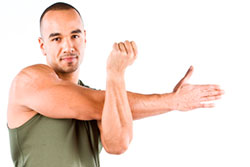Back to the February Issue
Dynamic vs. Static Stretching:
What’s the Difference?
By Amber Harding
Stretching is an important part of any fitness routine. Studies have shown that it is beneficial, but the question is, should you stretch before or after exercise?
According to Jen DeCurtins, a National Academy of Sports Medicine certified personal trainer, yoga teacher, and CrossFit trainer in Charlotte, North Carolina, the answer is both. “I recommend dynamic stretching before exercise and static stretching after workouts,” she says.
Dynamic Stretching: Before Exercise
Dynamic stretches use fluid motions to warm up your muscles in preparation for increased exertion. They also slowly increase your heart rate.DeCurtins says, “Dynamic stretches prepare the muscles and joints for the movements [you] will be performing in [your] workout.”
For some dynamic stretches to try, CLICK HERE.
Static Stretching: After Exercise
With static stretching you spend a set amount of time holding each movement. “You want to ideally hold static stretches for 30-60 seconds,” says DeCurtins. “This is helpful after workouts because it helps the body recover.”Keep in mind that when stretching, you might feel mild discomfort. Take deep breaths to fully experience the stretch. If you have sharp pain, decrease the depth of the stretch. If the pain persists, make an appointment to meet with a personal trainer or health care provider.
For some static stretches to try,CLICK HERE.
AMBER HARDING is a recent graduate from the Thompson Rivers University journalism program.
Eliza Demonstrates Dynamic Stretching.
Eliza Demonstrates Dynamic Stretching. (MP4, 01:40)
Eliza Shirazi, a student and group fitness instructor at University of Massachusetts Amherst, demonstrates walking lunges, windmills, butt kicks, and high knees.
Eliza Demonstrates Static Stretching.
Eliza Demonstrates Static Stretching. (MP4, 01:59)
Eliza Shirazi, a student and group fitness instructor at University of Massachusetts Amherst, demonstrates the spinal twist, low lunge, butterfly, and hip-flexor stretch.

